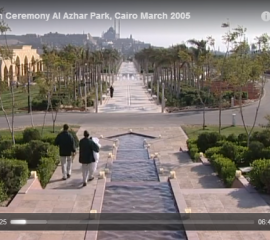Cairo park restores ancient glory - CROWDED CAIRO GETS ITS OWN VISION OF CENTRAL PARK - 2005-03-25
The park was financed by the Aga Khan Trust for CultureA 30-hectare park built from scratch on what used to be a 500-year-old garbage dump topping one of Cairo's poorest neighbourhoods is ready for inauguration.
The opening ceremony on Friday will be presided over by Imam Aga Khan, the 68-year-old spiritual leader of Shia Ismaili Muslims who first devised the project more than 20 years ago.
The park, which lies close to Cairo's landmark Citadel and was financed by the Aga Khan Trust for Culture, features Andalusian-inspired fountains, rows of palm trees and flowery hills and a stunningly intact 12th century wall.
Excavated from under tons of trash and rubble, the Ayyubi wall - named after famous Muslim ruler Salah-al-Din ibn Ayyub - is dotted with 15 towers and boasts several gates.
One of the gates, Bab al-Barqia, will serve as one of the park's entrances when the site's restoration is complete in two years, offering a welcome green space in the over-populated metropolis.
'We went around to see other gates in Cairo to help reconstruct Bab al-Barqia,' Elisa Del Bono, an Argentine restoration specialist assigned to the wall, explained.
Traces of blue paint on one of the adjacent towers may indicate it was once blue all over, she said.
Excavation
The excavation, which began in 1999, uncovered stones dating back to pharaonic times and recycled by the site's Ayubid, Mamluk and Ottoman rulers and artefacts from the Ottoman Empire's late period.
Shia Ismaili leader Agha Khan (L) financed the Cairo park project
'We've founds dozens of smoking pipes,' French archaeologist Julie Monchamp said, pointing to several boxes filled with ornate handmade pipe heads made out of clay.
'There used to be a factory in the area and tubes made of bamboo were affixed to the heads,' she said, also showing fragments of clay jars, some glazed in vibrant blue hues.
Less than a metre away from the wall lies a mish-mash of shacks and freshly painted apartment blocks, part of the low-income Dar al-Ahmar neighbourhood that was partly rehabilitated under the $30 million project.
Job training and employment opportunities were also created for its inhabitants, some having to do with the restoration of the wall and landmark buildings in the area such as a 13th century palace, a 12th century mosque, a 19th century school and an Ottoman house.
'Each intervention we do is dated so that it's clear it was renovation work rather than part of the original structure,' Dina Bakhum, a young Egyptian woman, said.
She is overseeing the restoration of Umm Shaikh Shaaban mosque whose missing minaret top was reconstructed.
Renovation and revival
At the site, two men come across a heavy carved wooden door which they haul to a makeshift workshop in one of the mosque's rooms where young Egyptian men and women are busy waxing a similar door or delicately brushing away dust on yet another one to uncover an intricate and colourful geometric design.
The minaret of the Umm Shaikh Shaaban mosque was restored
Another group is patiently exposing 16th century frescoes of trees and leaves adorning the wall of what used to be a Quranic study room.
'We hope that the building will be revived once its renovation is completed in 2006. It could serve as a cultural centre or a place to teach calligraphy,' Bakhum said.
The mosque's prayer room is, however, very much in use and local worshippers come and go as they please.
The site's renovation stimulated the rediscovery of lost skills, such as the renovation of intricate traditional windows (mashrabiyya) and wood-carved doors.
Hundreds of men and women have also found work as gardeners in the park.
- 3474 reads
 Ismaili.NET - Heritage F.I.E.L.D.
Ismaili.NET - Heritage F.I.E.L.D.